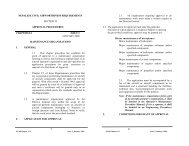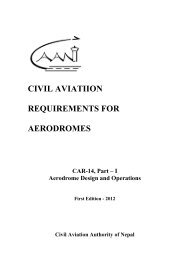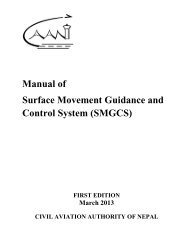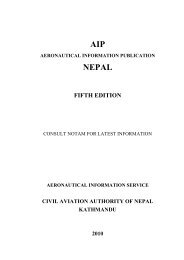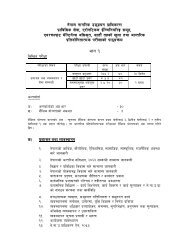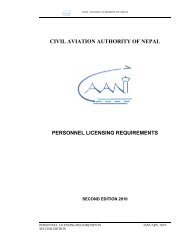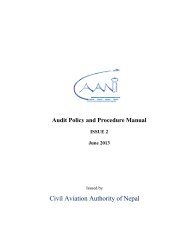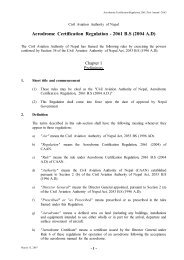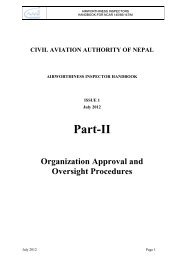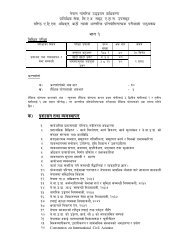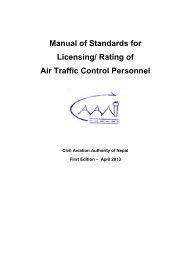CAAN Souvenir 2010.FH10 - Civil Aviation Authority of Nepal
CAAN Souvenir 2010.FH10 - Civil Aviation Authority of Nepal
CAAN Souvenir 2010.FH10 - Civil Aviation Authority of Nepal
- No tags were found...
You also want an ePaper? Increase the reach of your titles
YUMPU automatically turns print PDFs into web optimized ePapers that Google loves.
<strong>CAAN</strong> <strong>Souvenir</strong> 2010Fund arrangement from government resource is almostimpossible. But, if we plan right from now a certain percentage<strong>of</strong> funds can be accumulated. For example, one <strong>of</strong> the fundingresources would be the revenue generated from the sale <strong>of</strong>tree logs <strong>of</strong> the forest land under SIA development area.Secondly, Airport Development Fee-ADF (say, $15 and $3per departing international and domestic passengersrespectively) may be charged in TIA. Estimated annualcollection <strong>of</strong> ADF would be about $ 20 million. Out <strong>of</strong> this60% (or about $ 12 million annually) should be depositedin "SIA Development Fund". This fund should be commerciallymanaged to earn interest as well. In a seven years periodthis fund with interest may reach up to $100 million.Implementation & Institutional Arrangement:Presently, <strong>CAAN</strong> is the statutory right to regulate airspace,to operate airports and to provide air traffic services throughout<strong>Nepal</strong>. Nevertheless, for SIA development project, governmentmust play crucial role. It is also desirable that a separatesubsidiary company under <strong>CAAN</strong> be established for projectimplementation. After project completion, the operationalresponsibility be given to a separate fully autonomous SIACompanyTo Sum up:The development <strong>of</strong> SIA should be taken as a primary necessity<strong>of</strong> economic development <strong>of</strong> <strong>Nepal</strong>. As the passengeravailability for SIA is not so attractive, SIA should be developedfor long term financial sustainability with the Airport City and‘Aerotropolis’ business model. Kathmandu-Nijgadh-Birgunjfast track/ express way will be the pre-requisite for SIAdevelopment. By some technicality, airports are to be locatedin a considerable distance from the main city or capital. Thusmost <strong>of</strong> the new international airports have an inherentchallenge to develop from hinterland to a business hub andan air city. Feasibility study, master plan and development <strong>of</strong>SIA should be guided from this principle.Pr<strong>of</strong>essor Dr. Kasarda saya “The true challenge is planningto get the Aerotropolis(or airport city) right.Ê If there is notappropriate planning, airport-area development will bespontaneous, haphazard, and economically inefficient andultimately unsustainable.Ê The aerotropolis model bringstogether airport planning, urban and regional planning, andbusiness-site planning, to create a new urban form that ishighly competitive, attractive, and sustainable." Let this quotationbe our guideline to airport, airport city and aerotropolisdevelopment in Nijgadh.References:1 <strong>Civil</strong> <strong>Aviation</strong> Airport Project ADB PPTA:NEP 38349-01, Finalreport Volume-1, Airport Planning and Engineering, 20092 Kasarda Aerotropolis Expansion Theory, , Accessed on 9/27,20103 Evolutionchapter1.pdf, , Accessed on 7/12 ,20104 TIA Flight Moovement Data for 2009 As per the records <strong>of</strong>TIACAO, Flight Permission Sectin5 Second-international-airport, , Accessed on 30/09, 2010*Deputy Director, <strong>CAAN</strong>3912 th Anniversary Publication



